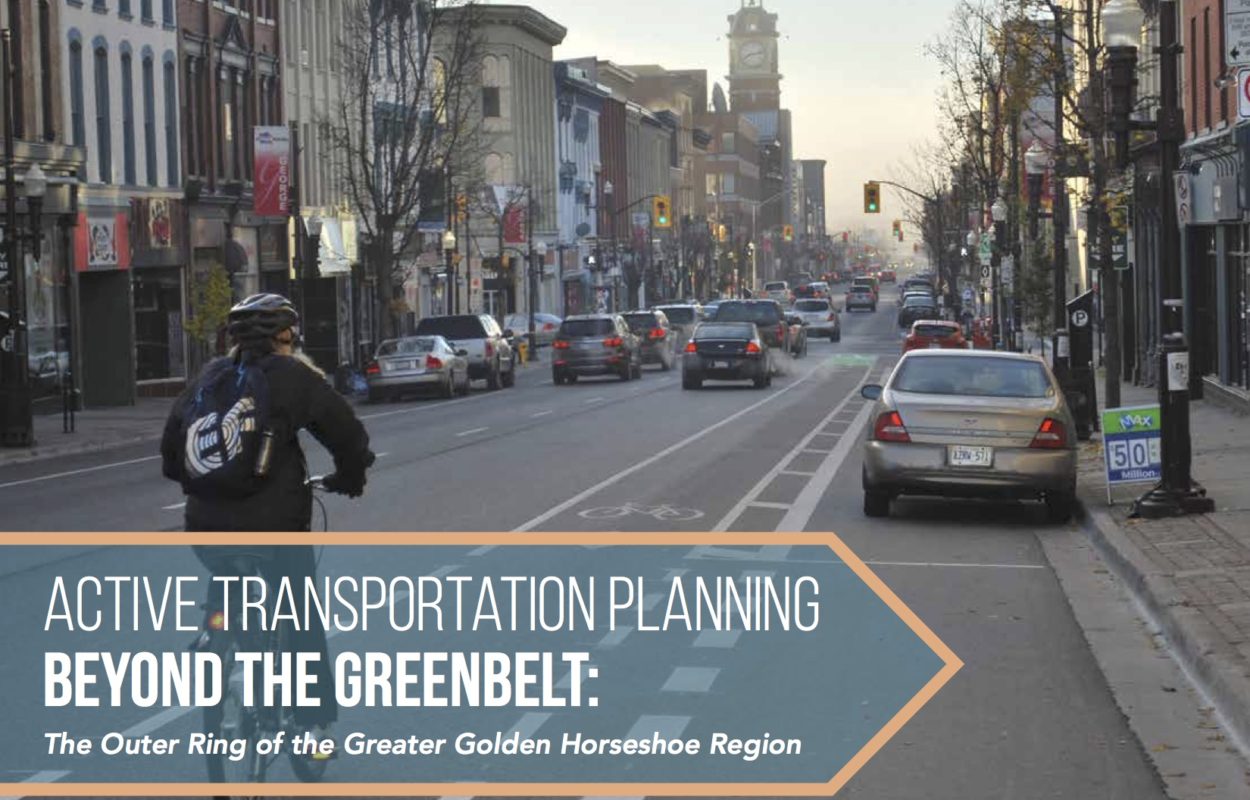
TORONTO, March 16, 2017. The Centre for Active Transportation (TCAT) is pleased to release Active Transportation Planning Beyond the Greenbelt: The Outer Ring of the Greater Golden Horseshoe Region, a new book that profiles 13 recent projects that have improved conditions for walking and cycling in unique contexts beyond the Greater Toronto and Hamilton Area.
The Greater Golden Horseshoe Region is bifurcated by the Greenbelt, a broad band of permanently protected land. The Inner Ring, the most densely populated and urbanized section, is on one side of the Greenbelt, and the Outer Ring, comprised of more rural and smaller communities, is on the other side.
The book profiles 13 Outer Ring active transportation project examples in three different contexts: 1) rural: Wellington, Northumberland and Simcoe Counties, 2) suburban: Brantford, Barrie, Cambridge, Orillia, and the Region of Niagara, and 3) urban: Guelph, Peterborough, Kitchener, St. Catharines, and the Region of Waterloo.
These 13 projects are wide-ranging and at times unexpected, as smaller towns, suburbs, and rural areas often face the perception that walking or cycling are not viable travel options there. Physical conditions such as topography and large distances can act as barriers, as do the presence of provincial highways that run right through the middle of historic small towns. Despite these and other challenges, the municipalities in this book have successfully implemented off-road trails, paved shoulders, bike lanes, sidewalks and more to create spaces that encourage active transportation.
“Our research demonstrates that bike lanes and pedestrian projects are happening throughout the region,” says TCAT Director Nancy Smith Lea, “so this is definitely something to celebrate. For the future health and vitality of this region, the need to build complete communities is just as critically important to address in small and rural municipalities as it is in large cities.
Study highlights:
- 12 of the 19 jurisdictions surveyed have active transportation master plans, or are in the process of developing them.
- Outer Ring active transportation projects are being built across a variety of settings, from compact centres to more rural, very low-density areas.
- Many of the same types of pedestrian and cycling strategies applicable to larger urban centres (e.g. bike lanes, multi-use paths) are being employed with success across the Outer Ring.
- Unique solutions are underway to address specific conditions in the Outer Ring, such as paving shoulders on rural highways. Ontario’s Bill 31 Making Ontario’s Road Safer Act was an important precondition for this, as it made it legal for cyclists to ride on paved shoulders.
- The #1 challenge faced by nearly every municipality is funding. Of the 13 featured municipalities, five were recipients of the new Ontario Municipal Cycling Infrastructure Program.
The book is a joint project between TCAT, Dr. Raktim Mitra, Assistant Professor and Co-Director: TransForm Laboratory, School of Urban and Regional Planning at Ryerson University and Dr. Paul Hess, Associate Professor, Department of Geography and Planning at the University of Toronto, with funding from the Government of Ontario through the Places to Grow Implementation Fund.
Book Launch Event
A launch event for the book is open to the general public, and will include a panel with Jennifer Juste, Transportation Demand Management Coordinator at the City of Guelph, Sarah Wilhelm, Senior Planner at Wellington County, and Dr. Paul Hess, one of the lead research investigators. It will take place on Tuesday April 4th, 2017 from 6-7:30 p.m. at Ryerson University Student Learning Centre, 341 Yonge St, Room 508, Toronto. Free tickets + advance purchase of book available on Eventbrite. Print copies of the book are $10 at launch event or $15 online.
About The Centre for Active Transportation (TCAT)
TCAT, a project of the registered charity Clean Air Partnership, advances knowledge and evidence to build support for safe and inclusive streets for walking and cycling. We believe that active transportation plays a critical role in creating environmentally and economically sustainable cities. Find out more at tcat.ca.
